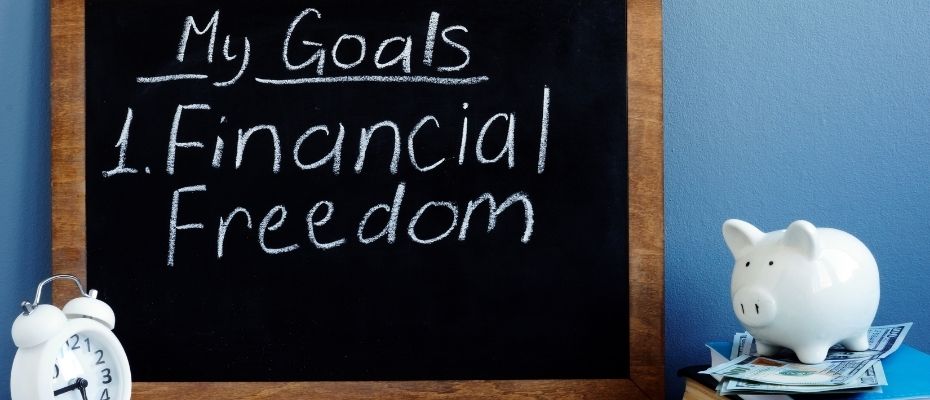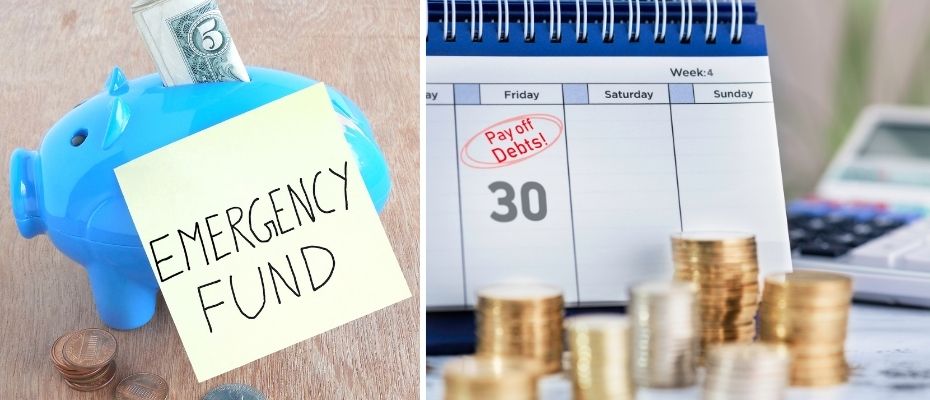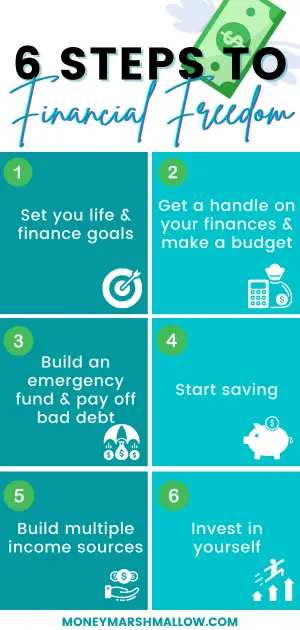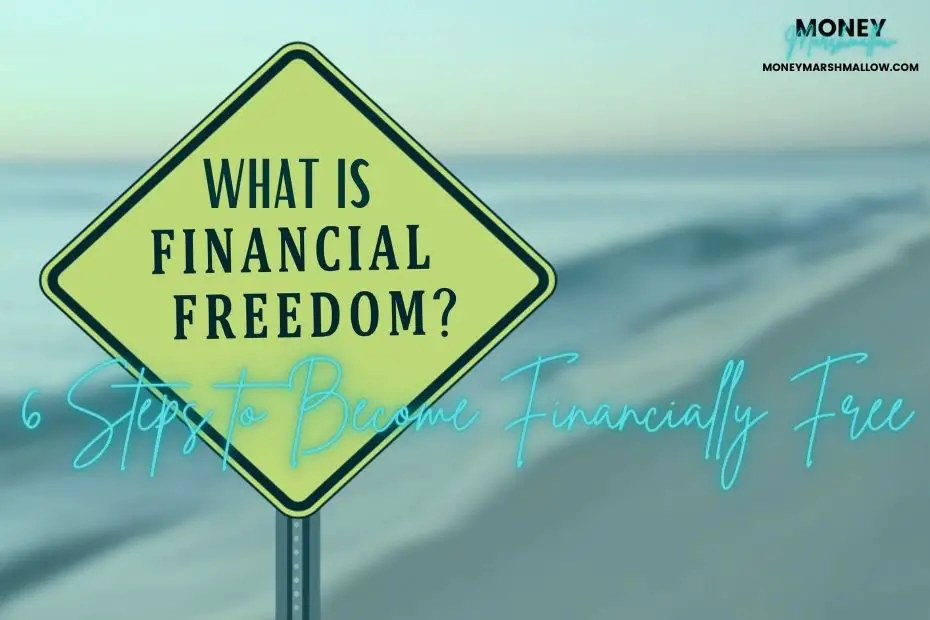What is financial freedom and how to achieve it?
Financial freedom is a dream for many but can mean different things to different people. It helps you to create and maintain the life you desire, whether it was about buying what you want and when you want, having no debt or simply being rich. But why do so few people actually become financially free?
My guess is that most people don’t start their journey to financial independence simply because they don’t know where to start. They might also be afraid of the changes in their lives they’ll have to make to get there. Because let’s be honest, financial freedom doesn’t usually “just happen”. It requires a financial plan of action and a willingness to commit to the plan. To help you get going in the right direction, here are 6 steps to achieve financial freedom.
What is financial freedom?
Financial freedom is a status you have when you have enough income or savings to pay your living expenses without having to be employed or dependent on others. Income earned without having to work a job is commonly referred to as passive income. In simple terms, this means that your money is working for you instead of you working for money.
Financial independence allows you to afford the lifestyle you want for yourself and your family without having to stress about money. Because we all have different aspirations for life, financial freedom also looks different to everyone.
Before you read further, take a moment to think about what financial freedom means to you.

How to become financially free?
As I’m currently on my own financial freedom journey, I wanted to share with you what I have learned so far. Follow these six simple steps and start working towards financial independence today!
Step 1: Set your life & finance goals
As silly as it might sound, many of us, including myself, find it hard to dream big and set ambitious goals. And it’s hard to even explain why this is the case. Perhaps this is down to limiting money beliefs, including fear; fear of not hitting the goals or the changes we need to make to get there. Fear can hold you back from achieving what is possible and will probably keep you stuck where you are, not moving forwards. This is common but obviously isn’t helpful.
When you have answered these questions for yourself, write down the goals you want to achieve. The more specific your goals, the higher the likelihood of achieving them. Also, don’t forget to include by when you aim to reach the goals. For example, your goal might look something like this:
Make enough money from additional income sources to be able to only work part-time in 2 years’ time.
OR
Earn enough passive income to replace my monthly salary, and be able to quit my job within 3 years.
OR
Retire at 40 as a millionaire.
If your main goal is a few years (or even more) ahead, I would highly recommend breaking it down and setting some additional milestone goals. This will make it much easier to keep track of your progress. It will also help you to keep motivated and to stick to the plan when you can hit your milestones and see success on your way to the main goal.

Step 2: Get a handle on your finances
Knowing your starting point is the next important step in your financial freedom journey. Get started by identifying and writing down all your income, savings and debts, including the following:
- Income: Salary, side hustle income and any other regular income you may have
- Savings: Savings accounts, ISAs, retirement plans, investment funds, cash
- Debt: Mortgage, student loan, car loan, credit cards and any other debt you might have
Once you know your current money situation, it’s time to make a budget – and stick to it. Financial freedom doesn’t happen by accident and therefore money management is an essential part of building wealth and becoming financially free.
For many, this can be the hardest part because it usually means reducing your spending. Identify what our regular outgoings are and how you could spend less. This might mean less eating out or takeaway coffees, but always keep in mind that you are in this for the long run! Financial freedom is all about delayed gratification over instant gratification. Even many self-made millionaires had to learn frugal living before rising to affluence. The small sacrifices now will help you reach financial independence faster.
Life is meant to be enjoyed too. So finding a balance between your goals and small pleasures is important. But before spending money, ask yourself two questions: Is this going to make me happy? Or will this help me stay more motivated on my journey long-term?
To further level up your finances or to simply make up the costs of some of the things you’re not ready to cut off, consider picking up a side hustle.
Step 3: Clean up your finances
Step 3 includes two parts: building an emergency fund and paying off debt.
When it comes to savings, the statistics are looking dreadful; according to ING, more than a quarter of UK households have no emergency fund. Before putting money anywhere else, build a rainy day fund of at least £1000. This helps you to cover unexpected costs in case of an emergency, such as your car or boiler breaking down. Having this safety net will be beneficial for your financial wellbeing but will also be able to provide you with peace of mind.
Credit cards and similar high-interest consumer loans (also known as bad debt) are toxic if you are trying to become financially free. Make sure to pay off the full credit balance each month. Paying on time doesn’t only help you to avoid hefty interest but also allows you to build a good credit rating. Once you have cleared your high-interest debt, try to stay there for good. As a general rule of thumb, don’t buy something you can’t afford. Student loans, mortgages and similar long-term loans typically have much lower interest rates. Therefore, paying them off is not particularly an emergency.

Step 4: Start saving
After building an emergency fund and clearing up your debt, the next step is to start saving. You’ve probably heard the expression “pay yourself first”. What this means is that you put a specific amount of money in your savings account before paying anything else. By doing this, you ensure that you’re always putting money aside to invest in yourself. However, if you do the opposite, you only get whatever is left over. This usually isn’t enough to help you on your journey to financial freedom. The amount you should save each month mainly depends on your personal goals and how much you can realistically put aside.
In addition to moving money to a savings account, there are other ways you can pay yourself first too. For instance, if your company has a retirement plan, ensure you make full use of any matching contribution benefit. The company’s contribution is free money for your retirement at the end of the day!
Finally, if you like a challenge and would like to boost your savings further, a no-spend month can be a great way to do this.
Step 5: Invest & create additional income streams
After you have put your basic finances in order, it’s time to start building multiple streams of income via investing and passive income. The main benefit of diversifying your income is that you can spread the risk in case one income stream fails. As the old saying goes, don’t put all your eggs in one basket. Further to this, having multiple income streams also improves your earning potential.
Many people are so intimidated by the idea of investing that they might put it off or don’t do it at all. However, regular work income and budgeting alone are unlikely to win your financial independence. You will need to combine these strategies with investing and passive income. The sooner you start investing, the more time your money has to grow. That’s the power of compound interest!
In addition to financial products such as stocks, bonds and index funds, there are also various other ways to invest and earn passive income. If you’d like some ideas before you start doing further research on this, have a look at my recent article listing 9 passive income strategies that’ll make you money 24/7.
Step 6: Invest in yourself
Your habits and actions have a direct impact on your overall wellbeing and success. This is why investing in yourself has one of the best returns on investments you can have. Whether it’s investing in learning a new skill, developing yourself personally or professionally or tapping into your creativity, you must take care of yourself first. Here’s a couple of tips on how to invest in yourself and boost your financial freedom journey:
- Exercise regularly
- Read books and listen to podcasts
- Attend seminars and workshops
- Keep gratefulness journal
- Meditate
- Spend on experiences instead of material things

Conclusion: What is financial freedom and how to achieve it?
Whatever financial freedom means to you, I’m sure you agree that it’s all about you being in control of your money rather than your money controlling you. Having a financial freedom mindset also means making consistent decisions to invest in your long-term goals over short-term desires. Let’s wrap up by going through some key takeaways for your journey to financial independence:
- Set life and financial goals, both short and long-term. Create a plan of action for achieving those goals and stay committed to them.
- Make a budget to cover all your financial needs and stick to it.
- Pay off high-interest debt (such as credit cards) in full and on time. Avoid bad debt and keep an eye on your credit score.
- Create an automatic saving plan through your employer’s retirement plan and monthly transfers to your saving account. Make sure you have an emergency fund set up.
- Build various income sources through investing, passive income and side hustles.
- Invest in yourself.


I love how you’ve broken this down into clear steps that anyone can do- this is great! Thanks for sharing!
This is a great article! The first thing I learned about becoming financially free is that it’s all about our own behaviors. Our spending habits, our investing habits, our saving habits, etc, can really make or break our success. Thank you for sharing!
You’ve really broken these steps down well. Thank you very much for sharing
Very clearly you have explained the ways to gain financial freedom. It is very necessary to know how to save and expense in order to have a secured future.
Nice article! Financial freedom is one of the biggest goals of mine. Not so easy to achieve, but hopefully one day 🙂